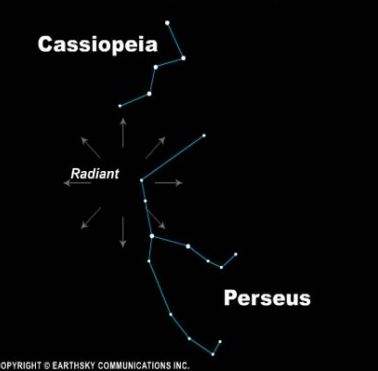 This year the Perseid meteor shower is strongest in the pre-dawn mornings of August 11 – 13. If it’s moonless, and it’s supposed to be, you may see 50 or more meteors per hour in the northern hemisphere, and about one-third as many in the southern hemisphere.
This year the Perseid meteor shower is strongest in the pre-dawn mornings of August 11 – 13. If it’s moonless, and it’s supposed to be, you may see 50 or more meteors per hour in the northern hemisphere, and about one-third as many in the southern hemisphere.

The meteors will come in spurts with some down-time between. Since eyes may need up to 20 minutes to adapt to the darkness of the sky, plan to spend an hour or more observing. The meteors come from a single point in the constellation Perseus, so a good tactic is to trace the meteors backwards to establish their origin.
So for the back-story: In Greek mythology, Perseus was the son of the god Zeus and the mortal Danae, whom he visited in a shower of  gold. This golden shower is what the Perseid meteor display commemorates. Well, when Perseus was a young man, he made a not well-thought-out promise to bring the head of the Gorgon Medusa to the man courting his mother. Which he did, but he had a lot of help: Zeus gave him a special sword and Hades’ helmet of invisibility. Hermes lent Perseus his famous winged sandals, and Athene threw in the aegis, a polished shield. When Perseus got to the Gorgons’ cave, he found Medusa asleep, and using the shiny aegis to watch her reflection, he was able to approach and cut off her snaky head without being turned to stone by her evil look. Whew! Life was quite exciting in those days!
gold. This golden shower is what the Perseid meteor display commemorates. Well, when Perseus was a young man, he made a not well-thought-out promise to bring the head of the Gorgon Medusa to the man courting his mother. Which he did, but he had a lot of help: Zeus gave him a special sword and Hades’ helmet of invisibility. Hermes lent Perseus his famous winged sandals, and Athene threw in the aegis, a polished shield. When Perseus got to the Gorgons’ cave, he found Medusa asleep, and using the shiny aegis to watch her reflection, he was able to approach and cut off her snaky head without being turned to stone by her evil look. Whew! Life was quite exciting in those days!

Leave a Reply